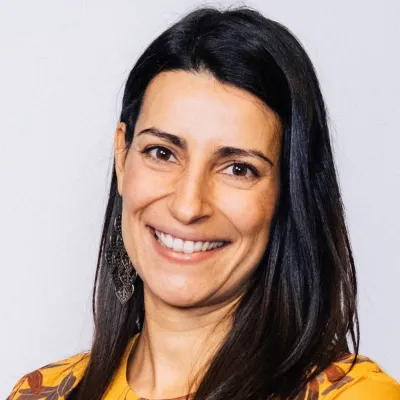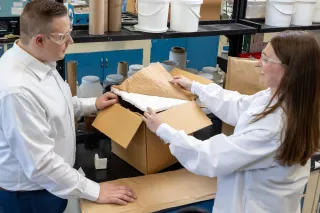VTT's pilot environment in Tampere is a hub for innovation, particularly in developing new plastic compounds, plastic and textile recycling, and metal powders as well as their processing techniques. The facilities are used to create, for example, novel coatings for packaging, cellulose-based materials, 3D-printed multi-metal engine components and more efficient plastic recycling processes.
Read the summary
- Key technologies include advanced sorting, washing, and mechanical recycling systems, utilising sensors and spectrometers for process optimisation and ensuring high-quality recycled materials.
- The facilities also support research in novel packaging materials, printable electronics, and the development of biocomposites and foamed plastics for diverse applications, contributing to sustainable industrial advancements.
- VTT's expertise in 3D printing with metal powders enhances efficient production of optimally designed components, offering businesses a competitive edge with reduced need for large investments in infrastructure.
This summary is written by AI and checked by a human.
One of VTT's core missions is to develop, test, and scale innovations towards commercial products and industrial-scale production. The pilot environment for future materials and processes in Tampere embodies this mission. The facilities provide a testing ground for ideas' functionality, feasibility and customer value – laying a solid foundation for business growth.
From plastic waste to new products
The circular economy is becoming a top priority across many industrial sectors. The work at VTT’s pilot facilities in Tampere focuses particularly on recycling technologies for plastics and textiles.
Before recycling, materials must be cleaned and sorted into different fractions. VTT is developing a plastic sorting line capable of identifying and separating plastic pieces from electronic, packaging or mixed waste using optical cameras, hyperspectral imaging and, in the future, radar technology.
One of the main bottlenecks in the plastic waste business is the poor availability and low quality of materials. These challenges can be addressed through batch and type-specific plastic waste washing.
"In spring 2026, we will launch a plastic waste washing pilot to develop the washing process using sensors and radar systems. The goal is to optimise the process by identifying the lowest possible temperature and water consumption that achieves satisfactory cleaning results for each plastic fraction," says Senior Scientist Marjaana Mussalo.
High-quality mechanical recycling of plastics requires relatively clean and consistent material streams. At VTT, sensors and spectrometers placed throughout the advanced mechanical recycling line measure properties of the molten plastic mix—such as colour, chemical composition and viscosity—in real time.
This data is digitally stored for real-time process control or future analysis, accelerating the search for the ideal composition for the desired product. Model-based process control utilises the collected sensor data to respond to changes in material properties and ensure a consistent, high-quality outcome.
In addition to recycling, VTT Tampere also explores the processing of demanding plastic products. The facilities include a cleanroom, where plastic melt compounding and extrusion can be carried out in a dust-free environment. This is necessary, for example, to produce high-quality high-voltage insulators and medical devices.

From worn-out work coats to new textiles
While recycling plastic bottles into textiles has become commonplace, recycling textile waste back into textiles remains more complex. Challenges arise from the variability of textile materials, treatment agents, detergent residues and possible carbon fibre content.
“We’ve succeeded in producing fibres from many recycled materials that match the strength of standard textile fibres, without using chain extenders or polymerisation,” explains Research Team Lead Taina Kamppuri.
The textile recycling line can process large textile items such as work jackets, pillows, and protecting gloves without pre-cutting or grinding. The equipment can also be used for the mechanical recycling of construction waste, plastic film or bin bags, as well as for the pre-treatment of materials for pyrolysis and compacting construction debris. VTT holds several patents related to this process.
Novel packaging materials and printable electronics
Innovations related to various plastic films and coatings also take place in the Tampere pilot facilities. “We’re studying how to combine plastic materials and coatings with fibre-based materials,” says Senior Scientist Johanna Lahti.
The pilot environment for thermoplastic films and coatings allows the development and testing of entirely new materials for use in liquid, flexible and rigid packaging, as substrates for printed electronics and as film materials in the construction industry.
The highly customisable environment supports development of bio-based materials and bioplastics, using cast film and blown film extrusion techniques with one or multiple materials. Film properties can also be modified using orientation equipment. Water-based dispersion coatings can be studied through wet coating methods. "Dispersion coatings can also be combined with extrusion coatings to gain benefits of both materials," Lahti adds.

Foamed plastics from packaging to shoe soles
By foaming the plastic, part of the material is replaced by air to form cellular plastic. This process saves material, energy and costs and results in very lightweight and insulating products. Cellular plastics are used, for example, in packaging, construction, vehicles and shoe soles.
VTT is developing cellular plastics using two different techniques: extrusion and particle foaming.
“In extrusion foaming, solid plastic is transformed into cellular plastic via heat, friction, and foaming agents. This technology is utilized in various applications, such as frost and building insulation. We’re studying the suitability of different materials and foaming agents to find fossil-free alternatives. We’re also combining the foaming process with 3D printing,” says Senior Scientist Teijo Rokkonen.
Particle foaming, used typically in styrofoam production, involves forming parts from small, foamed beads using steam. VTT can test various materials and optimise the foaming process. The process has also been used for testing styrofoam recycling.
Recyclable and biodegradable biocomposites for various applications
Biocomposites are versatile materials that have better strength-density performance compared to wood or thermoplastics alone and are lighter than metals or fiberglass composites. They combine thermoplastic polymers either being recycled plastics or bioplastics with cellulose, flax, hemp and other natural fibres or industrial side streams like sawdust, lignin or textile waste.
“VTT has developed materials from entirely renewable raw materials for injection moulded products suitable for applications such as furniture, electronic casings and car interiors. Also, special biocomposites are prepared in a paper machine environment to felt-like structures those can be thermoformed into items such as furniture or vehicle parts or construction materials,” says Senior Scientist Kirsi Immonen.
VTT is investigating which material combinations yield the strongest, most durable, and purpose-fit end products. Biocomposite development can be integrated with foaming research to combine lightness and strength for the end-product. Research is also being conducted on how to design fully recyclable biocomposite products. Material development is supported by modelling and simulation.
Biocomposites can be processed via extrusion, injection moulding, 3D printing and thermoforming. Utilising Foam Forming technology it is possible to create recyclable products with impact resistance comparable to fibreglass composites.

From metal powders to engine components with 3D printing
3D printing has revolutionised the manufacturing of metal components, offering great freedom in designing optimally shaped, lightweight, high-performing parts. For instance, an electric engine stator can be 3D-printed into an optimised shape, incorporating microscopic holes to reduce losses. This boosts engine efficiency. However, not all known metal alloys are suitable for 3D printing, making material development vital for innovation.
Typically, the experts at VTT’s pilot facilities in Tampere develop a material that matches the client’s application needs while leveraging the advantages of 3D printing – offering a competitive edge. The performance of the developed material is usually piloted by producing a demonstrator component that mirrors its industrial counterpart and can be validated under real-life conditions. Based on this, companies can more easily proceed to develop marketable products.
“Material development combines modelling with automated sample processing and characterisation. This enables faster identification of optimal material compositions and processing parameters for 3D printing and the target application. Only the most promising options proceed to metal powder production and piloting," Research Team Leader Tomi Lindroos explains.
Printing requires metal powder. At VTT, the powder is made by melting the desired raw material blend and by processing it in an atomisation unit with a gas stream. The powder is then sieved into a particle size distribution suitable for the chosen 3D printing method to ensure optimal processability.
3D printing can also be used for automated production of test material variations. VTT's printer can prepare 12 samples of different alloy variations on a single substrate to study their properties, phase structures, hardness, strength and overall printability. The current equipment allows simultaneous printing of six different powder blends either into new alloys, or by combining materials like iron and stainless-steel layer by layer or in gradients. This would be very challenging with traditional methods.
Thanks to the comprehensive research infrastructure and expertise at VTT Tampere, companies can pilot and develop their innovations without massive investments. The equipment is modular and easily adaptable to different needs.
If you're interested, get in touch with us.





